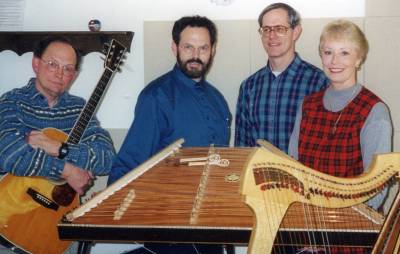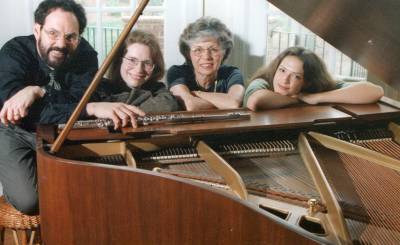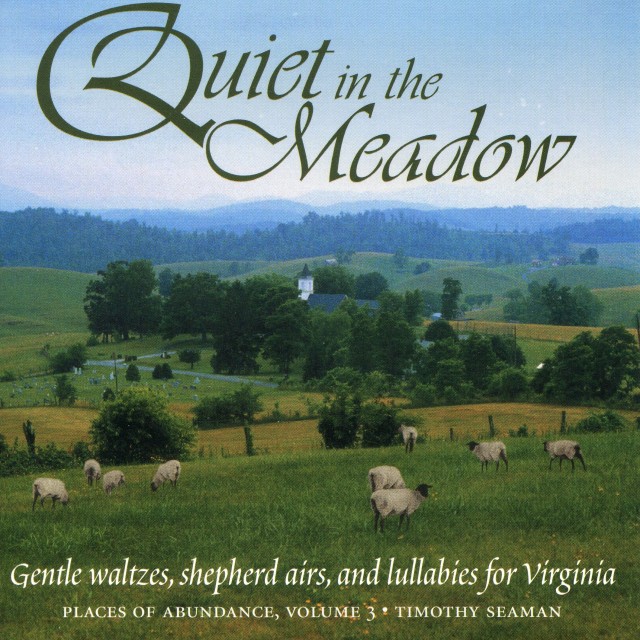Often people ask me which of my albums would be best for personal quiet times, meditation, yoga, dentists’ offices, babies’ naps, chiropractor clinics, massage therapy, reading, going to sleep, … you get the idea! Instrumental music is frequently desired for peaceful experiences, and my instruments can be highly regarded as appropriate for relaxation.
Well, the music in my head is actually pretty dramatic and exciting, but I always did intend to make a mellower album than the others, and the time seemed to have arrived in 1999 after the Williamsburg album Celebration of Centuries was done. I made my usual tune list, again a very long one.
What to do with the list? Well, I decided this time to give a copy to various musicians I play with and see what on the list they personally would like to contribute. I also had some specific ideas of my own of what some of these gifted folks could do, and I presented those thoughts too.
This was to be the second album recorded entirely by Henry Smith, both at his Outback Studio and on location. In the midst of the project Henry opened and dedicated his new studio building out back of his house (hence the studio’s name!) and we conducted our second phase of recording and mixing in that wonderfully designed facility.
How about topics? I wanted to include lullabies --- in fact, the working title was ‘the lullaby album’ --- as well as shepherd airs and gentle waltzes. So that’s the pattern the list took as we thought of titles. And those three themes eventually turned out to be printed on the cover below the album title.
I had a hunch that the tracks should begin with a ‘gathering tune’ in which I’d start with only one instrument and by the end of the track there would be many! All me! I think I played more instruments at the same time (thirteen, I believe, through overdubbing) on the charmingly beautiful French melody ‘La valse pour les pitites jeunes filles (Waltz for Little Girls)’ than at any other time in my albums. Starting out with solo hammered dulcimer, I soon added a second dulcimer, then guitar, then bowed and plucked psalteries, then bamboo flute, bodhran, shaker, etc. till it was a happy, gentle, big ensemble. The coda was intended to be a fade, so we went on and on to facilitate that --- but the end of the fade section actually sounded like an ending, so we decided to just keep it as it was.
I love key changes. Not always --- some pieces seem to work best using other methods of development within the same key, and it’s also wise for an entire album to have a variety of kinds of changes --- but generally, I love to change keys! For the opening waltz I decided to start in the high octave of G, then abruptly move to the lower octave of C (down a fifth), then for the final verse and coda suddenly jump down again but by a strange interval, a minor third, to A, along with the lead instrument changing to a bright-sounding Indian (Asian) bamboo flute. I loved this element of interest and intrigue; my wife Ro thought it was jarring. But this particular time I followed my own hunch instead of listening to counsel! (I still think I was right.)
Track 2 was an intentional solo free improvisation in the studio on a bamboo flute with an octave effect and large reverberation, using the pentatonic scale (GAB DE) as the basis, and with no ideas in my head as I began. We kept the first take! This became the title track, ‘Quiet in the Meadow.’ It was quite a contrast from the opening number, but very palatable.
I wanted to write more new compositions for Shenandoah National Park, and I kept my eyes open for good opportunities for that, especially to draw attention to the best-known places in the Park, Skyland and Big Meadows. On this album came the perfect chance! I bought my current hammered dulcimer from Sam Rizzetta in early February of 2000, my Dusty Strings D600, halfway through the recording time, so I wanted to use that big new sound and extended range to develop a new arranging technique I had in mind: my ‘pianistic separated hands’ method. I decided to compose a simple but moving Irish-style air for the album and for the Park simultaneously in order to develop the technique --- ‘Big Meadows Twilight,’ in the lower part of the instrument, in the key of A and its relative minor, F# minor.
As somewhat of a veteran player who hadn’t separated his hands like a pianist all that much, this was a pretty painful thing to try, but oh, the excitement of hearing the beauty and emotion of the combination of chord shifts, rhythms, and melody coming together! This kept me motivated as I strove to cross the threshold of the new method. So ‘Big Meadows Twilight,' one of my favorite pieces to play even today, was the very first tune with triangular-shaped right-hand chords.
Our daughter Karen was a first-year student at the University of Virginia in Charlottesville that year, so I got the idea of taking photos for the cover art at Big Meadows! I picked her up from school and we drove the hour up into the Park, where we set up the dulcimer in the twilight; I played the tune 'Big Meadows Twilight' while she ran around in all directions snapping shots as the sun set. The silhouette of one photo made it to this project’s inside page, and another found its place on the cover of the next album, the Virginia Parks compilation Common Wealth.
Our other daughter, Laurie Jean, was fifteen and a blossoming singer. When she saw the list she immediately leapt at the chance to sing ‘This Is my Father’s World.’ (She was thinking surely of God as Father, not of me in this case!) I decided to use this as an opportunity for another new composition, this time a countermelody for the hymn that I called ‘Skyland.’ I laid it all out on music paper, consciously using the ‘Parks' and 'God' motifs I’d developed in 1995 as part of the melodic structure, and tried it out and found the melody worked beautifully on its own as well as simultaneously with the other tune. In the studio I first recorded rhythmic arpeggios in zig-zag form on the hammered dulcimer for the entire piece, then added the ‘Skyland’ melody on the first verse, then brought Laurie Jean in to record vocals: verses two and three in two different keys. She put on the headphones and proceeded to sing exuberantly into the mike for a single take! We didn't need to try it again! Then… she asked if she could experiment with a harmony. We said, ‘Sure,’ and again the first take was a thrilling keeper! I added ‘Skyland’ on flute as a countermelody on her second verse and a final restatement of the new tune more slowly and pensively, and Henry contributed his inspiring bass guitar, and we had what I consider one of the high points of my albums.
Ardie Boggs had recorded a charming moderate-speed version of the Scottish air ‘Jock o’ Hazeldean’ on one of her Celtic harp albums, and I’d fallen in love with it. Now that we were performing together as a duet and as a trio with Phil Skeens, I asked her if we could play our buoyant trio version live in the studio. Her personal choice to add to that was a hymn she loved, ‘The King of Love My Shepherd Is,’ a paraphrase of the twenty-third Psalm. Her approach turned out to be accidentally in 4/4 time instead of ¾, and I was glad --- there were already too many ¾ pieces anyway! (This video is a similar duet with Ann Robinson recorded more recently.)
Since Phil was there at the studio that day, we proceeded from there to record our slow duet of the great O’Carolan air ‘Si Bheag, Si Mhor’ on guitar and flute, again live --- no overdubs. Henry’s gift for use of reverb added a great deal to the sound.
Paulette Murphy had played magnificent piano explorations of Bach and a folk hymn on earlier albums. I asked her to consider the Brahms Lullaby and William Bradbury hymns (‘He Leadeth Me’ and ‘Savior, Like a Shepherd Lead Us’ --- shepherd themes galore!) and I wanted Millie Becker to play the Bach lullaby from the Christmas Oratorio (‘Sleep, My Beloved’) and his ‘My Heart Ever Faithful’ along with my flute. I remembered that there is a nine-foot Steinway Grand in the recital hall at the College of William & Mary, so we rented the hall and piano and Henry came from Mechanicsville with his remote setup, and we all converged on the hall to record the four planned pieces. Three of these found their way to the final album, adding an elegant, evocative piano element.
Well, I had the vision of Henry’s warm voice and colorful guitar expressing the African-American spiritual ‘Angels Watching Over Me’ in a somewhat upbeat way, so I asked him to work on that on his own. One day when I showed up at the studio he played it for me: a startlingly ingenuous and cleverly constructed version, even with happy whistling in the coda. Bravo! Years later a mother and daughter came up to me and said that the young girl asked for that song to be played every night as she went to sleep, and they had even painted the words on her wall.
My mom had always loved a version of the twenty-third Psalm that she’d learned as a child in India, ‘The Lord Is My Shepherd, No Want Shall I Know;’ I decided to record this all by myself as a flute quartet, and transcribed it in such a way that the bass part could be done by the lowest flute and put through an octave effect for depth. This quiet moment is a sort of central pivotal point in the track listing.
'All Through the Night' --- a Welsh melody of great depth and beauty --- was essentially a hammered dulcimer solo, with some meaningful 'pads' by a second dulcimer and bass by Henry. Another of my posts features that, including a .pdf of the chord-rolling method.
‘Taps’ --- the good-night piece of the military, evoking scenes in meadows --- was composed right here at Harrison’s Landing during the Civil War, so it’s a Virginia song. I played it on a low-pitched bamboo flute with a second flute echoing each phrase in the distance, followed by an improvisational reprise of the title piece on a different bamboo flute.
Some lilting waltzes on hammered dulcimer with other instruments such as harmonica, melodica, and bowed psaltery improvising right along, filled out the patchwork of gentle pieces: ‘Shepherd’s Wife’s Waltz’ (two of the themes in that title!), ‘Westphalia Waltz,’ and ‘Midnight on the Water.’
Jonathan Hounshell, a former fifth-grade student of mine, was now a professional graphic artist in Tennessee, and I hired him for the cover art. I sent him a stack of photos I’d taken that included meadow scenes, sheep, and little girls (our daughters long before). I told Jon I wished I had a good shot for the front cover of sheep in a field, so he fulfilled that desire by superimposing sheep from a snowy field in Singers Glen in the Shenandoah Valley onto a summer scene of Drapers Valley --- beautiful! Karen and Laurie at Humpback Rocks on the Blue Ridge Parkway in 1990 were chosen as the little girls for the back cover. And these photos were taken of the musicians:
 (by Cindy Smith)
(by Cindy Smith) (by Bill Becker)
(by Bill Becker)
Shenandoah National Park has carried this album, along with Here on This Ridge and Wayfaring Stranger, in their shops for many years. Numerically it’s in second place, behind Here On This Ridge: By 2014 we’ve had 11,000 tapes and discs made of Quiet in the Meadow.
I decided to print the twenty-third Psalm (by the ancient shepherd David, and translated by an English team under King James I in 1611) in the liner:
The LORD is my shepherd; I shall not want.
He maketh me to lie down in green pastures;
He leadeth me beside still waters. He restoreth my soul;
He leadeth me in the paths of righteousness for his name’s sake.
Yea, though I walk through the valley of the shadow of death, I will fear no evil:
For thou art with me; thy rod and thy staff they comfort me.
Thou preparest a table before me in the presence of mine enemies;
Thou anointest my head with oil; my cup runneth over.
Surely goodness and mercy shall follow me all the days of my life;
And I will dwell in the house of the LORD forever.





Comments